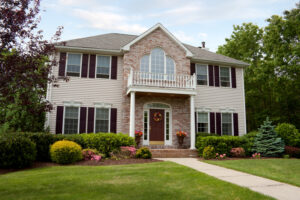Table of Contents

Choosing the right siding for your home can be a tough decision to make. Your siding protects your home from the elements and plays a crucial role in improving your curb appeal. Two of the most popular options include vertical and horizontal siding.
Each type of siding has its benefits and downsides, and choosing the right type for your home can seem daunting. To determine which is best suited for you, we’ll discuss the differences between vertical and horizontal siding and its pros and cons.
The Pros and Cons of Horizontal Siding
Horizontal siding, also known as “lap siding,” consists of exterior boards that are hung from left to right horizontally and parallel to the house’s foundation. This siding type is often associated with ranch, colonial, and traditional-style homes. Materials commonly used for horizontal siding include wood, vinyl, aluminum, and fiber cement.
Lap siding has several unique advantages and disadvantages that homeowners should consider before selecting. These include:
Pros
- Affordability: Horizontal siding is generally less expensive to install than vertical siding, making it a popular choice for homeowners on a budget.
- Timelessness: Considered a timeless and classic look, horizontal siding has been used for decades in residential homes throughout Northern Virginia.
- Installation: Its simple design makes horizontal siding much easier to install than its vertical counterpart.
- Variety: Featuring a broad range of available sizes, colors, and styles, horizontal siding offers a suitable solution for virtually any stylistic preference.
Cons
- Durability: Compared to vertical siding, horizontal siding is more susceptible to damage, including water damage, mold, and rot.
- Maintenance: Due to the horizontal placement of the siding, it’s much harder to clean and maintain horizontal siding versus vertical siding.
The Pros and Cons of Vertical Siding for Your Home
Vertical siding, conversely, features planks installed from top to bottom (vertically) and perpendicular to the house’s foundation. This style has become increasingly popular in residential homes but was historically used primarily on commercial buildings.
Vertical siding is available in various styles, including flat panels, board, and batten. It can be produced in a variety of materials and is often associated with rustic, farmhouse, coastal, and craftsman-style homes.
If you’re thinking about installing vertical siding, it’s important to consider the following pros and cons:
Pros
- Design: Vertical siding offers a unique and trendy look that can make your home stand out from the crowd.
- Maintenance: Because of its placement, vertical siding is much easier to clean than horizontal siding.
- Durability: The placement of vertical siding also helps prevent water damage, making it more durable compared to lap siding.
- Aesthetics: Vertical siding can make your home appear taller, giving it a more spacious, impressive look.
- Variety: Since most horizontal siding can be installed vertically; this gives you more options to choose from for your exterior.
Cons
- Complexity: Vertical siding installation is often more complicated and takes longer than installing horizontal siding.
- Cost: Compared to horizontal siding, vertical siding can be much more expensive to install.
- Materials: Because of its design, vertical siding requires more materials than horizontal siding, increasing time and costs for your project.
- Value: Since vertical siding is less traditional, this might negatively impact your resale value when it comes time to sell your home.
How To Determine Which Siding Is Best Suited for Your Home
It’s important to note that the pros and cons of each type of siding vary on your specific needs and design preferences. When deciding between vertical and horizontal siding, there are several factors to consider, including:
- Aesthetic Appeal: Consider your home’s overall look and style, then choose a siding option that complements it.
- Cost: Determine your budget first so you can choose a siding option that fits within it.
- Installation: Think about the complexity of the installation process and how this might impact your ideal project timeline — especially if you have a target completion date.
- Durability: Consider the climate and weather in your area and how these might contribute to premature wear and tear depending on your siding selection.
Protect Your Home With Beyond Exterior’s Expert Siding Installation in Northern Virginia
At Beyond Exteriors, our team has years of experience helping homeowners in Northern Virginia find the perfect siding for their home. From vertical to horizontal siding, we can provide expert guidance and installation to ensure your home looks beautiful and is protected. With us, you can trust that your home is in good hands.
Contact us online or call us at (703) 830-0863 to request a free siding installation estimate today throughout the Northern Virginia area.
